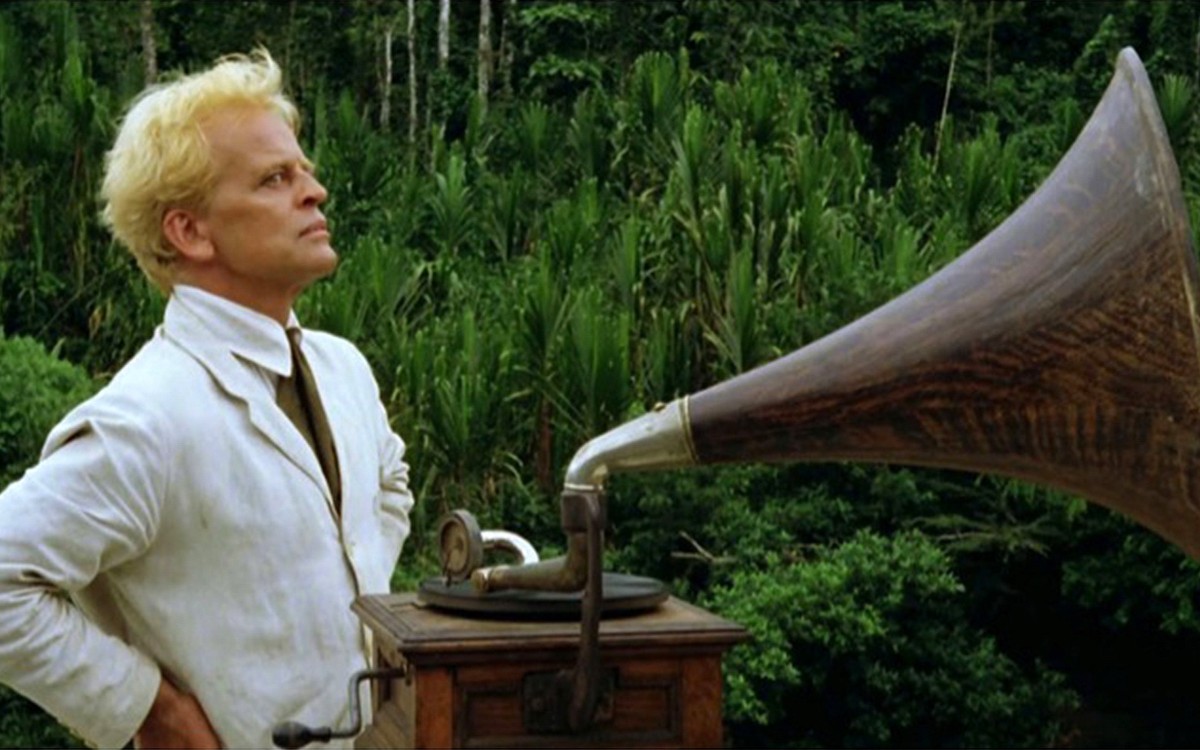Fitzcarraldo

Werner Herzog
Germany – 1982

Screenplay: Werner Herzog
Cinematography: Thomas Mauch
Production: Werner Herzog Filmproduktion, Pro-ject Filmproduktion, Filmverlag der Autoren, Zweites Deutsches Fernsehen (ZDF), Wildlife Films Peru
Language: German, Spanish, Italian with English subtitles
Duration: 158 min
Color: Color
Synopsis: Brian Sweeney “Fitzcarraldo” Fitzgerald is an Irishman living in Iquitos, a small town east of the Andes. This eccentric entrepreneur has an indomitable spirit, but he is a terrible businessman. He dreams of building an opera house in Iquitos, and the booming rubber industry should readily supply the necessary capital. The parcel he leases from the Peruvian government for exploitation is nearly inaccessible, but with money borrowed from his paramour Molly, the brothel owner, Fitzcarraldo devises an ingenious plan to transport a steamship over dry land. Defying skeptical competitors, his unfaithful crew, and Nature herself, and aided by the indigenous people of the jungle, Fitzcarraldo successfully drags the ship over the mountain via a complex system of pulleys and sweat. However, when the crew falls asleep after a drunken celebration, the native Chief severs the rope securing the ship, releasing it in sacrifice to the river gods, who would otherwise be angered that the humans have defied them by taking a short-cut. Although the venture ends in failure, Fitzcarraldo goes through with his plan to bring opera to Iquitos.
Notes:
Herzog, one of the best-known directors of the New German Cinema, experienced what could be called his first great commercial success with Aguirre, der Zorn Gottes (Aguirre, The Wrath of God) in 1973. With Klaus Kinski in the title role, Aguirre tells of a sixteenth-century conquistador’s titanic struggle against both the jungle of the New World, and the bureaucratizing forms of his own country’s urge to govern. In 1982 Herzog recapitulates much of Aguirre in Fitzcarraldo. Parallels between the two can be seen in the plot and setting (narrative adventure on the rivers of South America), the critical depiction of historical imperialism and colonialism, the shooting sites; and the cast (the notoriously wild Kinski, but also the Aguaruna people playing the “wild” Jivaro) Yet, despite all the similarities in plot, personality, and theme between the two films, Fitzcarraldo takes place in a radically different historical period of Western expansion—the late nineteenth century. Fitzcarraldo’s attempt to establish culture in the rain forest, unlike Aguirre’s mission in the tabula rasa of “his” new continent, does not coincide with his undertaking in the film. He must pursue his dream by an indirect route. Fitzcarraldo breaks the path to a vast quadrant of rubber trees in order to get financing for his quest: an opera house.
Fitzcarraldo seeks to blaze a trail establishing an infinitely reproducible circuit along the Amazon, Pachitea and Ucayali rivers in order to exploit untapped rubber resources. His imagination is sparked by a map showing the Amazon’s two tributaries nearly coming in contact with one another in the region marked by the name and image of the Jivaro, the “headshrinkers” who roam this area. By bridging the mountain separating the rivers, Fitzcarraldo would bring the Jivaro and the land bearing their name into the dominant economy and into the state’s domain. Herzog puts Fitzcarraldo in a world that only finds originality in a “flash of inspiration” that provides the initial energy for a new circuit to expand the circulation of state and capitalist power. An originary, traitorous explorer like Aguirre no longer could exist in the world of the rubber boom. But neither can the Jivaro. Fitzcarraldo’s only concern is with the flow of current on the three rivers, and he marks the spot controlling the contact between them with an “X” to indicate the future site of a settlement to be named “Fitzcarraldo.” Because Fitzcarraldo takes place in a world of reproducibility based on the circuit, third terms or mediators become essential. The circuit needs a contact that can be closed or opened to control movement. Fitzcarraldo envisions this as his personal role, but he also unwittingly plays this role for the state when he signs a contract with the government. Rather than breaking from the state as Aguirre did, Fitzcarraldo enters into an agreement with the Peruvian government, and in doing so he makes himself an imperial agent of expansion mediating between the state and the nomadic Jivaro. The role of the imperial agent as the engineer of expansion requires personal initiative, risk-taking, energy – in short, all the elements valorized in the ideology of the individual in liberal capitalism. The agent’s private agenda, however, need not be fulfilled in order to work for the state. As we shall see, Fitzcarraldo has done the job the government required of him even as his own plans dissolve.
The key to understanding the way the film deploys this tension lies in the central figure’s conception of “culture.” The notion of culture informing Fitzcarraldo’s enterprise and character corresponds to a particular historical conjuncture in Western imperialism, the moment at which the shift to domination through cultural control – rather than by way of physical force – begins in earnest.
Excerpt adapted from from Davidson, John E. “Contacting the Other: Traces of Migrational Colonialism and the Imperial Agent in Werner Herzog’s Fitzcarraldo.” Film & History (03603695) 24, no. 3/4 (September 1994): 66-83.


